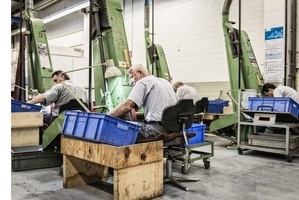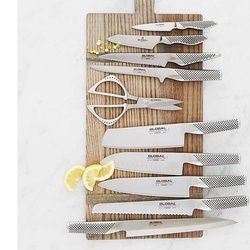In the world of knives, different types of steel are used to make each knife of the highest quality possible. Aspects such as the hardness and toughness of the steel largely determine the grade of the knife. Whether you are an amateur chef or a pro, a good quality knife is a must-have. Some knives are, however, more complex to use than others. Want to know more about the different types of knife steel? Then read on!

There’s a big difference between European and Japanese knives. This difference is mainly measured by the hardness of the knives. The Rockwell Hardness (HRC) (a test of how hard the steel is) is higher in Japanese knives. European knives usually have a hardness between 52-58 HRC, while Japanese knife hardness begins at 58 to 66 HRC. The toughness of the steel is partly determined by the complex alloys and exotic substances that are added to it. As well as the hardness and toughness of the steel, additions like Chromium (Cr), Molybdenum (Mo) and Vanadium (V) also influence the end result. For instance, knives with a chrome content of 11% or more are considered stainless steel.
Due to the different properties of their steel, Japanese knives are generally thinner than European variants. The high carbon content makes it possible to make the knives thinner, which causes less resistance while cutting. A disadvantage is that the knives are more prone to damage during heavier cutting work.
There are also several features that set stainless steel apart from carbon steel. Stainless steel makes maintenance easy. Acid and other substances have less influence on the quality. On the other hand, carbon can oxidise more quickly, but has the advantage of being easy to grind.
The following steel grades are listed from amateur use to professional use:
We will explain the steel grades one by one.
The appearance of Nitrum steel gives it a special position in steel classification. It is produced using a nitrogen enriched, environmentally friendly stainless steel formula. Since nitrogen is easily available in the atmosphere, the production process of nitrum steel causes very little damage to the environment. The blade and handle are heated several times, after which both parts are seamlessly forged together. This makes the knife bacteria-free and offers extra hygiene and safety. Due to the optimal cutting power and microstructure, nitrium steel can make that difference in the performance of knives for both professional and hobby chefs. The nitrum forged knives are available at Cookinglife exclusively from the brand Arcos.
The steel type X45CrMoV15 is a German steel, which is common in lower-grade knives. In addition to its own components, the X45CrMoV15 steel consists of 0.45% carbon and the remaining 15% is a composition of Chromium, Molybdenum and Vanadium. This steel is relatively cheap and is thus common among Western manufacturers. At Cookinglife, the Diamant Sabatier brand offers a wide range of X45CrMoV15 knives.
The steel grade X50CrMoV15 is also a German steel, which has a lot of similarities with the above X45CrMoV15 steel. The main difference is in the carbon content, which for the X50CrMoV15 is 0.5%. This German steel is very stain resistant and is used for knives from Wusthof and BK, among others. The steel is very tough and has a low sharpness retention how long the blade remains sharp). After repeated use, knives will generally wear out, for which you can use a knife sharpener or sharpening steel.

The so-called Cromova steel, better known as Cromova 18, is used in the knives from the brand Global. This steel consists of a chemical composition invented by founder Yoshikin. It is known that 18% chromium is incorporated in the steel, making the knives more resistant to corrosion. The steel also contains 0.8% carbon and has a very fine grain structure, making keeping the knives very sharp easy. This own patented type of steel is seen as one of the better steel types and exceeds the compositions mentioned above. For Japanese standards, the Global knives have a relatively low Rockwell hardness of 58 HRC. However, Cromova steel knives are very stain resistant. In addition, the knives are easy to sharpen compared to other Japanese knives. This is due to the relatively low hardness of the steel.
The key feature that sets Damascus steel apart is its several visible layers of steel. This method would often be used in the past to provide a stronger blade. A raw piece of steel would be forged into a longer piece, after which it would be folded back in half. Then, the piece of steel would be forged back together and the process was repeated. At the end of this process, the piece of steel would consist of dozens of layers. This had the advantage of distributing contaminants and eliminating weak spots in the steel. The steel absorbs an enormous amount of carbon through being heated several times, which also contributes to the hardness of the blade. Today, this technique has been perfected by incorporating other types of steel. As a result, the use of Damask steel has become an art form.